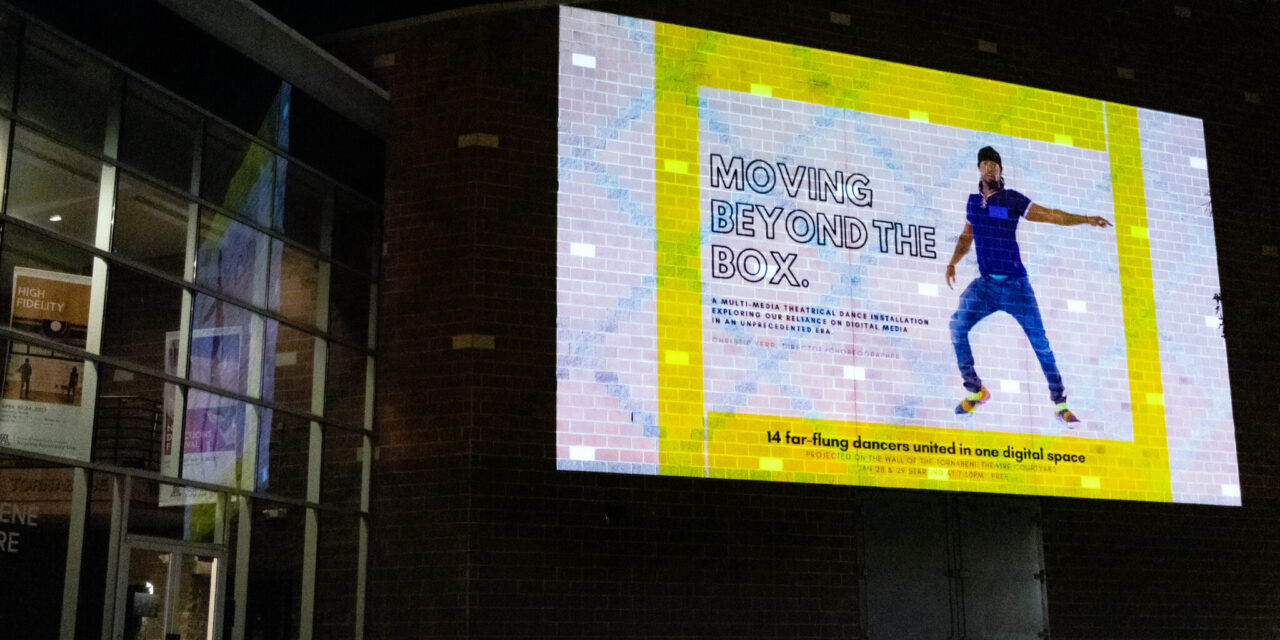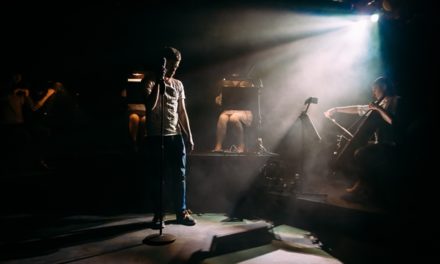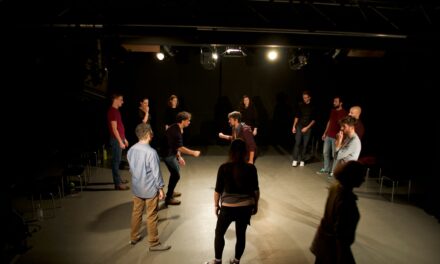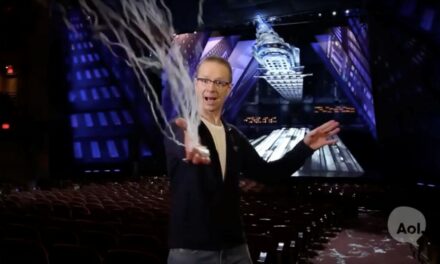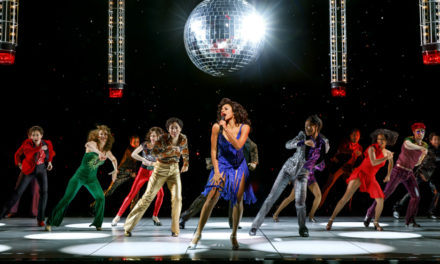In March 2020, when we were all quarantined at home, director/choreographer Christie Kerr looked for new ways to connect and continue to make art. She reached out to dancers from across the U.S. and sent them choreography to learn via an instructional video. The professional dancers recorded themselves in their various locations and sent the resulting videos back to Kerr. The dance videos were then edited together with snippets of media stories and sound in a cohesive virtual dance piece that unites the far-flung company of dancers in one digital space.
Kerr sat down for a conversation with me about this experiential installation that highlights the positive aspects of a technology-dependent era.
Michael Schweikardt: What is Moving Beyond the Box?
Christie Kerr: In this “pause” we’ve all been in with COVID, we are anxious to start to create new works again. Last summer, I started talking with Joe C. Klug (Creative Director) about new ways to create art – how we could utilize what we learned as we went online to incorporate multi-media with art and dance.
I hired fourteen professional dancers from across the United States (who were excited to work again as theatre and dance companies are still trying to recover) to participate in this project. I decided I wanted to help document the “stages of COVID” through dance and how we reacted to and learned from it. It’s broken down into three sections:
Section One reflects the start of the pandemic. Dancers are in their homes, dancing in their living spaces on Zoom (bored, tired, scared, but finding joy in movement again). This newfound technology (Zoom) was a lifesaver for us as we found new ways to connect and continue what we were passionate about.
Section Two reflects Summer 2020. We learn we can start to move and dance in a shared, masked, socially distant space – backyards, garages, studios, parks, etc. – continuing to find the joy in movement and feeling hopeful that we’re moving out of this pandemic with the development of vaccines.
Section Three reflects Fall 2020 & beyond. We shipped green screens to dancers and had them film themselves dancing in front of them. The green screens allow us to place them “together” in a shared space (when, in reality, most of them will never meet each other!) This was a new and exciting way to connect dancers together safely and continue to create new work.
There will be some news clips, graphs, etc. to help us follow a timeline. We’re going to weave them throughout the dances to help tell our story.
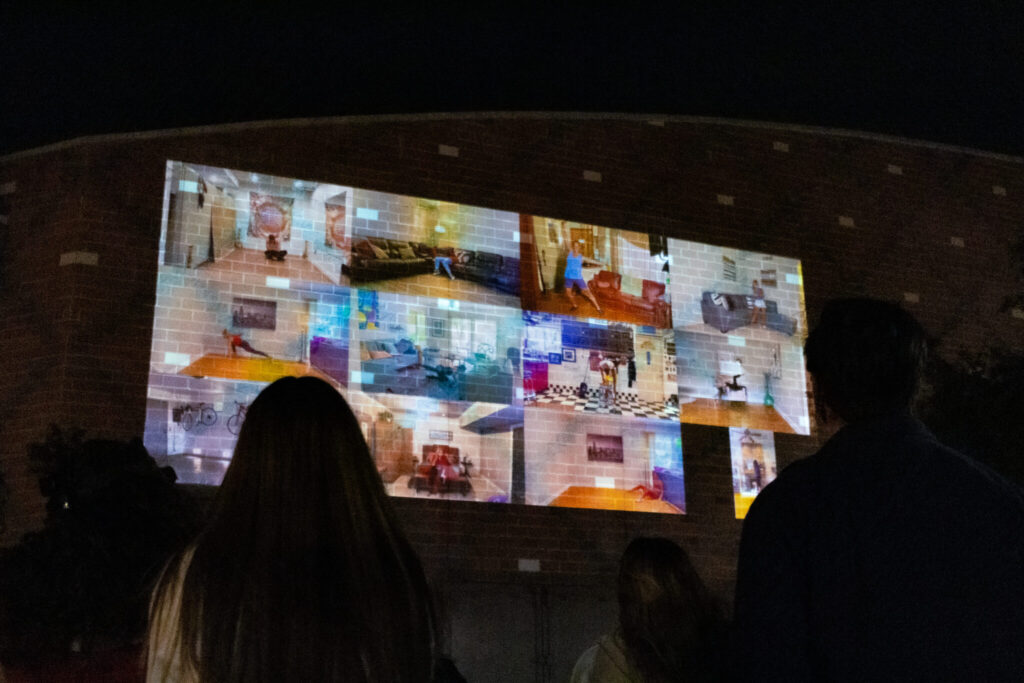
Moving Beyond the Box, School of Theatre, Film and Television, University of Arizona
MS: How is the piece made?
CK: I started by choosing the song. We decided that an instrumental piece would be the best thing for editing. I’ve always loved “Sing, Sing, Sing”. I find it has so many different musical themes and really tells a story. It’s kind of the polar opposite in terms of “mood” when you’re discussing COVID, but it seems to encapsulate the joy and necessity for movement that we all need in our lives. So, I listened to the song over and over again to find how I thought it could break down into different sections for storytelling. From there, I chatted with Joe (Klug) about some overall ideas and themes, and a rough storyboard developed. Then I started choreographing on my own.
I had three dancers in town for the summer and once I had most of the choreography loosely set, I met with them to see how the steps would look on them. They were able to help me see what was working and what I needed to adjust. During this pre-production phase, I continued to make changes and edit. Once the choreography was set, we recorded all the different sections for the dancers. I named all the various sections and recorded them from the front, the back (in a mirror) and walked through the choreography in a tutorial. Once I finished this and assigned what dancer did what section, I made lots of charts and detailed lists and emailed the dancers. All the videos, music clips and instructions lived in a Google Drive. They had a month to learn, rehearse on their own, and film everything. I just had them use their phones and a tripod. No fancy equipment. They could film and record in their homes, backyards, parks, etc.
To be honest, it was a little nerve-wracking just waiting to see what they’d come up with. I’m used to teaching a dance, cleaning, adjusting and rehearsing. But I learned during the pandemic, that I could teach things through a video if I was very detailed about every piece of choreography (head placement/hand placement, etc.).
In the next month, I’d log onto the Google Drive and anxiously look to see what had been uploaded overnight. It was like Christmas. It was so exciting to see what everyone was doing! I had lots of set choreography, but I did give the dancers freedom with some improv sections, and there were some really fun moments created by the different dancers. I did get a few texts, calls, and Face Times, when dancers asked for advice on what background looked best, but for the most part, everyone worked on their own.
Joe has been doing all the editing. I sit with him and help him with where things should fade, how to place the videos on our various panels, etc. It’s ended up taking quite a bit of time and it is a tedious process, but we’ve been working at it slowly throughout the late summer and early Fall.
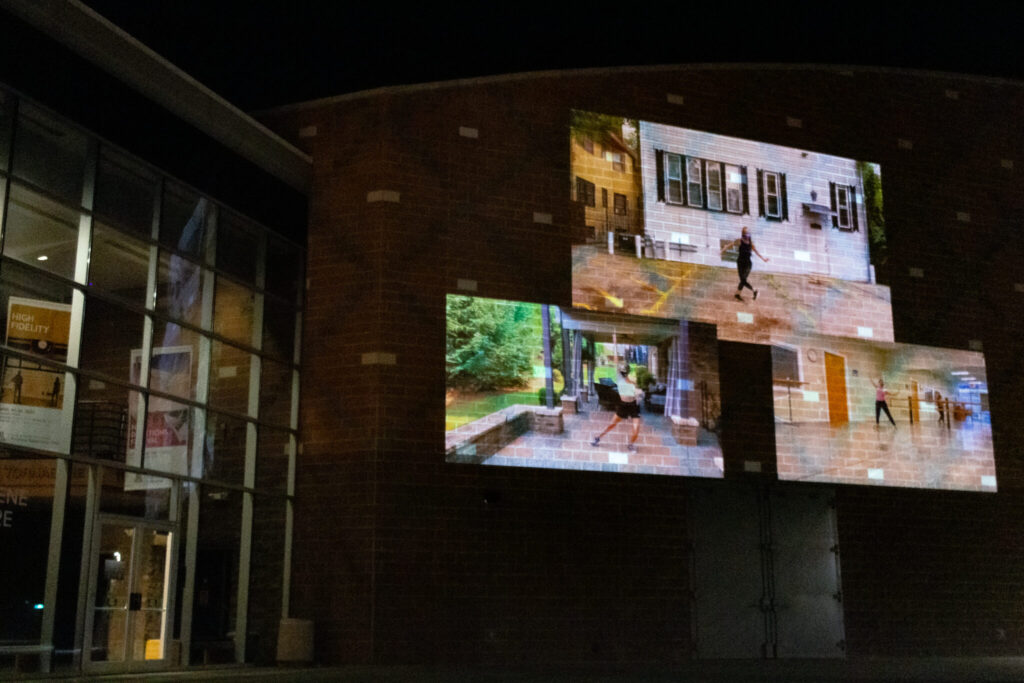
Moving Beyond the Box, School of Theatre, Film and Television, University of Arizona
MS: I am a set designer, so I am always interested in space – real and digital (although I am starting to see less of a distinction between the two). I am interested to know about the use of space in Section Three. Why move outside of the computer screen?
CK: I wanted this to be something new, different and collaborative. Joe had just done an outdoor projection installation in the Spring, and we started to brainstorm how we could make that work with dance. Our Projection Mapping Engineer/Sound Designer Matt Marcus was also very excited to figure out this “new” way to make art. We thought the green screen could be really fun and interesting. I was able to order and ship green screens to dancers to film the Section Three dances on their own. I think the most exciting element about this is that they will look like they’re sharing the same space, when they were really in a studio all by themselves. The decision to move the performance outdoors was partially due to the fact that we live in Arizona and the weather is usually very nice (we knew we wanted to do something in Fall/Winter which is a perfect time to be outdoors in Arizona) and partially due to the uncertainty of COVID. We figured doing something outside would be a safer option for everyone. Also, putting it outside makes it more accessible for everyone and hopefully exposes dance and art to people that might not normally see it. We’re hopeful people just out for a walk will discover the performance and stop to see what it’s all about. The building we chose to project on is our Theatre Building at the University of Arizona. It has some interesting surfaces. We tried a few tests and found that we could do some fun things with the various angles and textures it provides.
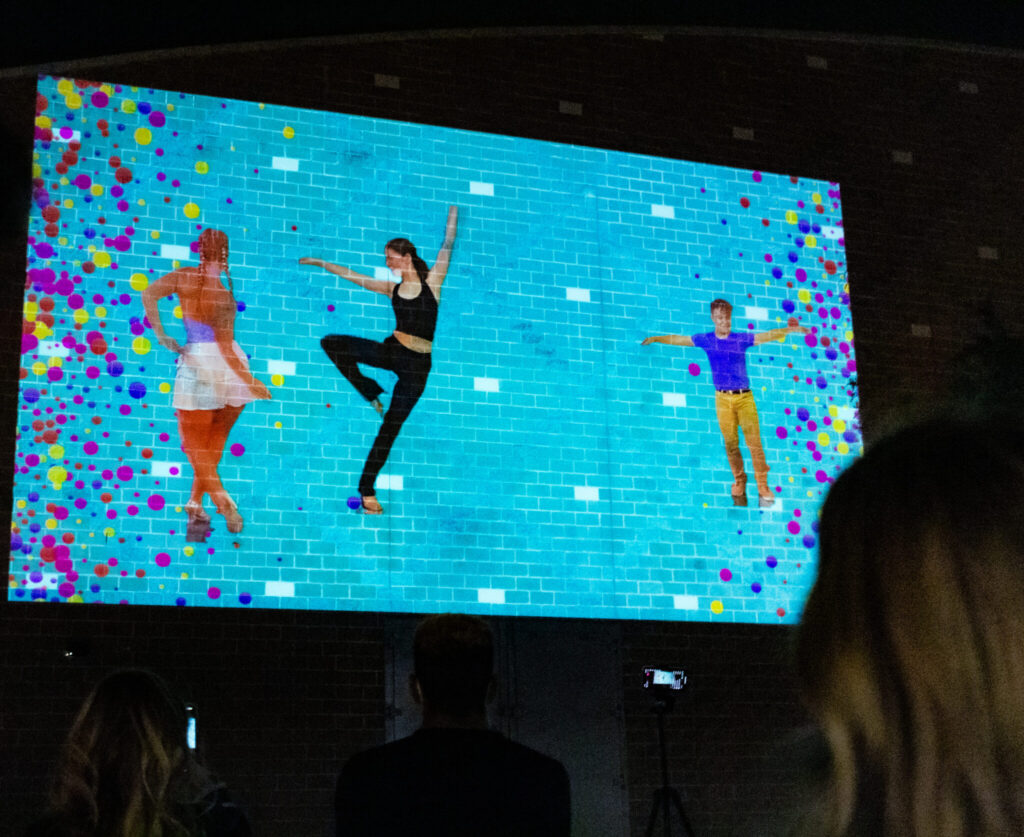
Moving Beyond the Box, School of Theatre, Film and Television, University of Arizona
MS: I would love to hear about any discoveries you all made along the way – what was unexpected and what did you learn?
CK: I learned so much from this project! This is a very collaborative piece, so finding time to connect with everyone and making sure they’re moving forward to be ready in time is exciting and challenging at the same time. What started as a fleeting idea – that maybe I’d film a choreographed dance – has turned into a multi-media collaborative piece. The video editing/programming is not my area of expertise, so working with Joe and Matt on all this has been fantastic. Christopher Mason has also joined us to edit all the green screen videos. Collaborating in this fashion has really been exciting for me. It’s very different from the work that I typically do as a Director/Choreographer in a musical. But, with the knowledge that I’ve learned, I’m hopeful I can use it for future projects and shows. I’ve already incorporated some of the ideas and concepts into a Choreography class I’m teaching, so I’m excited to see what discoveries we will make.
Moving Beyond the Box screened in the Theatre Building Courtyard on campus at the University of Arizona via a large-scale projection installation on January 28 & 29. The screening started at 7:30pm and played on loop for an hour.
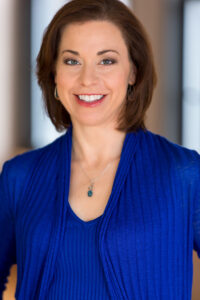
Christie Kerr, Director/Choreographer
Christie has worked throughout the country as a Director, Choreographer, Teacher and Performer. Selected theatres include: Porchlight Music Theatre, Little Theatre on the Square, Metropolis Performing Arts Centre, Circa ’21, BoHo, Bailiwick, Theo Ubique, Fox Valley Repertory, Williams Street Repertory, Prather Entertainment Group, Columbia College and the University of Arizona. Selected credits include: Spamalot, Crazy For You, A Chorus Line, The Drowsy Chaperone, Anything Goes, 42nd Street, Hairspray, Kinky Boots, Sister Act and Pippin. Christie is an Assistant Professor of Musical Theatre at The University of Arizona in Tucson. Prior to this, she lived in Chicago, IL where she was Adjunct Professor at Columbia College, Chicago. A graduate of The University of Michigan, Christie holds a BFA Degree in Musical Theater Performance and is a proud member of SDC and MTEA.
Moving Beyond the Box, a multi-media, theatrical dance installation
Creators
Director, Choreographer: Christie Kerr Assistant Professor, School of Theatre, Film & Television (TFTV)
Creative Director: Joe C. Klug Assistant Director, Experience, UA Marketing and Branding Management
Sound Designer, Projection Mapping Engineer: Matt Marcus Assistant Prof. of Practice, TFTV
Video Editor: Christopher Mason MFA Lighting Student, TFTV
Dancers
Daniel Altamirano
Jordan Beyeler
Naphtali Curry
Brach Drew
Jessica Miret
Maya Gold
Hannah Hufford
Reagan Kennedy
Joseph Kuchey
Michael Laverde
MarChello
Erin McDaniel
Conner Morley
Mollyanne Nunn
This post was written by the author in their personal capacity.The opinions expressed in this article are the author’s own and do not reflect the view of The Theatre Times, their staff or collaborators.
This post was written by Michael Schweikardt.
The views expressed here belong to the author and do not necessarily reflect our views and opinions.

